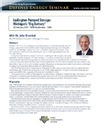Computers That Can Run Backwards
| dc.contributor.author | Denning, Peter J. | |
| dc.contributor.author | Lewis, Ted G. | |
| dc.date | Sept/Oct 2017 | |
| dc.date.accessioned | 2018-07-23T20:09:46Z | |
| dc.date.available | 2018-07-23T20:09:46Z | |
| dc.date.issued | 2017 | |
| dc.identifier.citation | Denning, Peter J., and Ted G. Lewis. "Computers That Can Run Backwards." American Scientist 105.5 (2017): 270. | en_US |
| dc.identifier.uri | https://hdl.handle.net/10945/59278 | |
| dc.description.abstract | Denning et al discusses the potential impact of reversible computations as computers that can run backwards, to reduce the energy consumption of each new generation of their chips. The birth of reversible circuits where researchers noted the relationship between information theory and thermodynamics that could solve the problem of giving off that form of heat and if other sources of heat can be remove is noted. The cost of reversible computers using lower switching speeds means less kinetic energy consumption called adiabatic switching and the impact of algorithms which pose another limit to energy are mentioned. | en_US |
| dc.format.extent | 6 p. | en_US |
| dc.publisher | Sigma XI-The Scientific Research Society | en_US |
| dc.rights | This publication is a work of the U.S. Government as defined in Title 17, United States Code, Section 101. Copyright protection is not available for this work in the United States. | en_US |
| dc.title | Computers That Can Run Backwards | en_US |
| dc.type | Article | en_US |
| dc.contributor.corporate | Naval Postgraduate School (U.S.) | en_US |
| dc.contributor.department | Mechanical and Aerospace Engineering (MAE) | en_US |
| dc.subject.author | Energy consumption | |
| dc.subject.author | International conferences | |
| dc.subject.author | Logic | |
| dc.subject.author | Switching | |
| dc.subject.author | Computer peripherals | |
| dc.subject.author | Energy | |
| dc.subject.author | Thermodynamics | |
| dc.subject.author | Computers | |
| dc.subject.author | Kinetic energy |




